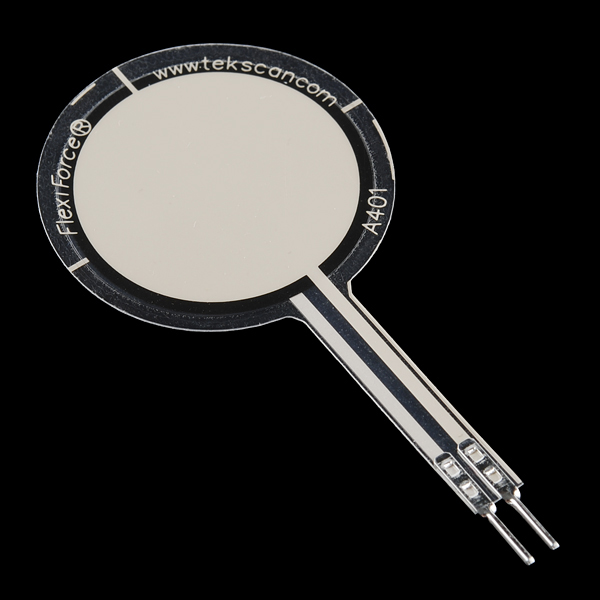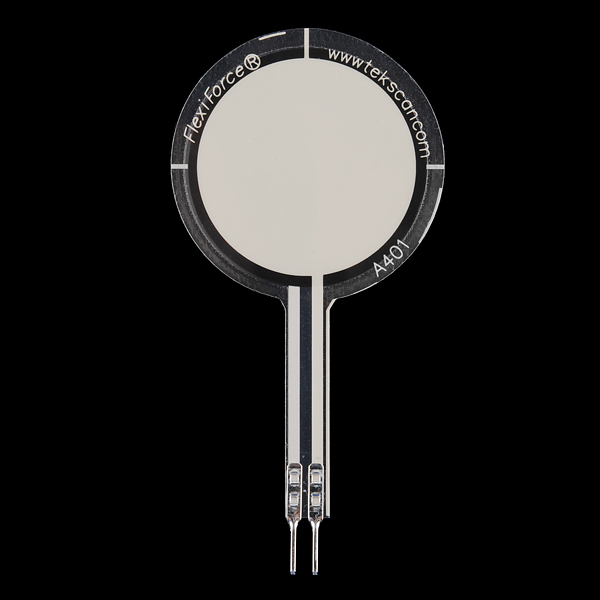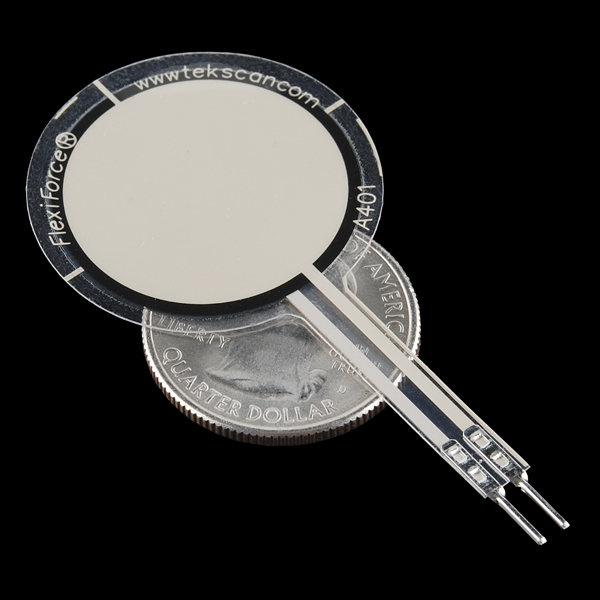FlexiForce Pressure Sensor - 25lbs (1" area)
This is a piezoresistive force sensor from Tekscan. The harder you press, the lower the sensor's resistance. Pressing hard, the resistance changes from infinite to ~50k. The sensor itself is thin and flexible, but the resistance does not change while being flexed. Resistance changes only when pressure is applied to the round area at the end of the sensor. Used as a presence sensor (someone standing), weight sensor, pressure sensor (impact testing), etc.
The overall length is about 2.25". The sensor comes with a 0.1" spaced, reinforced, breadboard friendly connector.
This sensor ranges from 0 to 25lbs of pressure.
- Datasheet (ZFLEX A401-25)
- Product Page
- Bildr Tutorial
- Quickstart Guide
FlexiForce Pressure Sensor - 25lbs (1" area) Product Help and Resources
Force Sensitive Resistor Hookup Guide
May 5, 2016
How to hook a force-sensitive resistor up to an Arduino to measure pressure variances.
Core Skill: Electrical Prototyping
If it requires power, you need to know how much, what all the pins do, and how to hook it up. You may need to reference datasheets, schematics, and know the ins and outs of electronics.
Skill Level: Noob - You don't need to reference a datasheet, but you will need to know basic power requirements.
See all skill levels
Comments
Looking for answers to technical questions?
We welcome your comments and suggestions below. However, if you are looking for solutions to technical questions please see our Technical Assistance page.
Customer Reviews
No reviews yet.




I want to detect a difference in pressure of about 15 grams to 50 grams. Would this sensor work?
To give more details: I will have a block that weights about 300g on top of this sensor (all the time), so that is the baseline weigh. THEN, on top of that block, I will add subjects that weights between 15g to 50g. Would this sensor detect that difference in weight?
I do NOT need it to be precise. I just need a YES/NO answer, to whether the extra weight is present or not.
Thanks
I want to place 3 of them in a "triangle" so I can increase the measurement surface, or is there a sensor that has a larger surface area ? I need to measure up to ounces/grams/ pounds, is there a way to wire them, series ? Parallel ?
This has a sensor area of about 3/4 square inch (the "one inch area" is clarified as diameter in the data sheet), making the "weight" measured by the pressure sensor (what a weird way to spec) close to two pounds per fathom of water. So the "25 pound" rating can measure up to the pressure of a little more than 70' of water.
Which raises the obvious question: is the sensor end of this waterproof? The datasheet gives no insight on this, but it is pretty clear from the picture that the wire end is not unless additional treatment is applied.
I wired it and got it to work with the code, but I'm having trouble balancing loads on it to take their measurements. Any ideas? I have access to a 3D printer, so I was thinking of printing a platform, but I wanted to do some research to see if anyone has had a similar problem.
When I use this sensor with Arduino as in the Quickstart Guide (put the sensor and a 1M ohm resistor in series as voltage divider), I saw a periodic waveform on my Arduino Serial Monitor when the sensor is loading with constant pressure or no pressure. I tried this with both sensors I bought and saw same problem. The amplitude of the waveform is about maybe 0.1, 0.2 V and the frequency is about 0.2 0.3 Hz, but it is still not ideal for my application.
Does anyone know what happened and why?
Is it possible to cut the pressure sensor to diameter with 20mm only? will it spoiled the pressure sensor? thank you.
Why are these so much more expensive than the FSRs?
I need to connect this sensor to a PCB using a receptacle-connector. I didn't a see spec for the flat pin dimension from the manufacture, but i measured them to be ~0.1" (2.54mm) apart.
Does anyone know of a 2-position flat pin receptacle for this sensor? (through-hole)
BUYER BEWARE, The description says "The sensor itself is thin and flexible, but the resistance does not change while being flexed. " However, when flexed the resistance changes by a very large amount.
I had a look at Bildr Tutorial & your Quickstart Guide, you guys are using a positive supply to the sensor but the manufacturer recommend a different setup using a negative supply with a inverting op-amp. Have you tested if the positive supply effects the accuracy of the sensor?
This sensor is a variable resistor, and there are a number of ways to measure resistance. We like using it in a voltage divider because of the simplicity of the circuit. The advantage of an op-amp design is that it buffers the voltage output for high impedance. Both techniques have their place; use whichever one is appropriate for your application.
More importantly, the op-amp design provides a linear output. The voltage divider output is very non-linear.
How long will it take to ship the item to Malaysia? And this is a Strain gauge right?
When I connect two of these to the arduino, one on pin A0 and the other on pin A1, if I press on one sensor, the second sensor's resistance changes also. How do I wire these up so that each sensor registers it's own reading independent of the other? I currently have them wired according to the examples above.
Have you tried to filter de inputs?? Use electrolitic capacitors between pins A0, A1 and GND
Will this sensor register a small pressure size, say from the end of a ball point pen? Or will this sensor only register large distributed forces?
The sensor will register pressure as long as it is inside the sensing area (in this case, the gray circular end). If you are only looking to sense pressure from something as small as a pin, we do have other force resistors with smaller sensing areas-check the related products below.